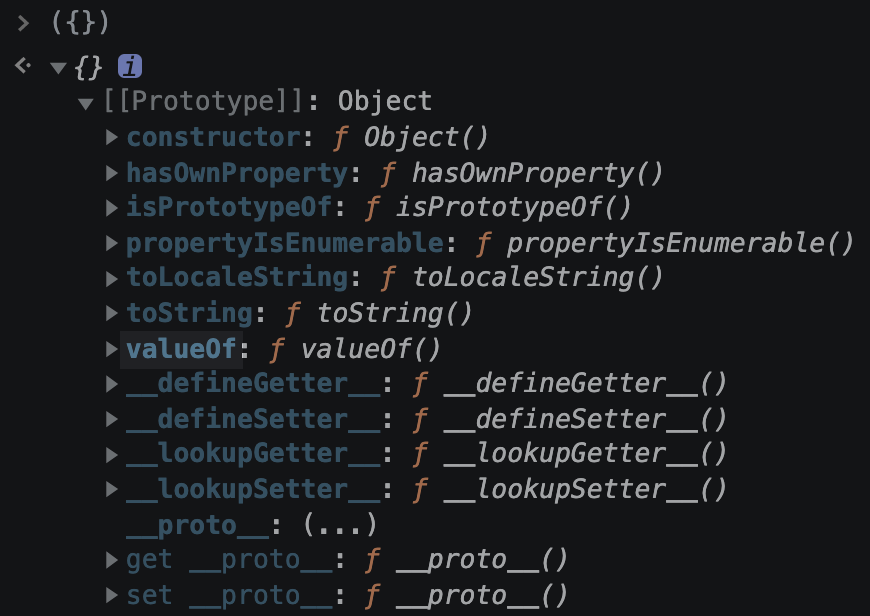.hasOwnProperty()
使用物件的 prototype hasOwnProperty 檢查。
不會遍歷原型鏈。
const profile = {
name: 'Sean',
age: 24,
}
profile.hasOwnProperty('name') // true
profile.hasOwnProperty('valueOf') // false
const profile = {
name: 'Sean',
age: 24,
}
profile.hasOwnProperty('name') // true
profile.hasOwnProperty('valueOf') // false
in
最簡潔的寫法,使用關鍵字 in 檢查。
但請留意 in 會去尋找整個原型鏈,可能得到預期外的結果,並造成微乎其微的效能差異。
const profile = {
name: 'Sean',
age: 24,
}
'name' in profile // true
/*
⚠️ 雖然以下 key 並沒有在 `profile` 中明確定義,
但因為它們存在於物件的 prototype 中,所以依然會得到 true。
*/
'valueOf' in profile // true
'toString' in profile // true
'hasOwnProperty' in profile // true
const profile = {
name: 'Sean',
age: 24,
}
'name' in profile // true
/*
⚠️ 雖然以下 key 並沒有在 `profile` 中明確定義,
但因為它們存在於物件的 prototype 中,所以依然會得到 true。
*/
'valueOf' in profile // true
'toString' in profile // true
'hasOwnProperty' in profile // true

Object.prototype.hasOwnProperty.call()
由於 JavaScript 未保護 hasOwnProperty,所以你完全可以複寫這個屬性,讓它刻意回傳錯誤的結果。
const profile = {
name: 'Sean',
age: 24,
hasOwnProperty: () => true,
}
/* 😢 現在無論傳入什麼都會得到 true */
profile.hasOwnProperty('🍺') // true
profile.hasOwnProperty(123) // true
const profile = {
name: 'Sean',
age: 24,
hasOwnProperty: () => true,
}
/* 😢 現在無論傳入什麼都會得到 true */
profile.hasOwnProperty('🍺') // true
profile.hasOwnProperty(123) // true
利用 Object.prototype.hasOwnProperty.call() 即可避免此情況發生,也不會遍歷原型鏈。
/* 😎 雖然冗長但最安全 */
Object.prototype.hasOwnProperty.call(profile, 'name') // true
Object.prototype.hasOwnProperty.call(profile, '🍺') // false
/* 😎 雖然冗長但最安全 */
Object.prototype.hasOwnProperty.call(profile, 'name') // true
Object.prototype.hasOwnProperty.call(profile, '🍺') // false
Object.hasOwn()
ES13 推出的新特性,旨在取代 Object.prototype.hasOwnProperty(),寫法相較之下更直觀簡潔。並且和 Object.prototype.hasOwnProperty.call() 一樣,即使複寫了 hasOwnProperty 依然可以得到正確的結果。
不會遍歷原型鏈。
const profile = {
name: 'Sean',
age: 24,
hasOwnProperty: () => true,
}
Object.hasOwn(profile, 'name') // true
Object.hasOwn(profile, '🍺') // false
const profile = {
name: 'Sean',
age: 24,
hasOwnProperty: () => true,
}
Object.hasOwn(profile, 'name') // true
Object.hasOwn(profile, '🍺') // false
其他常見但有陷阱的方法
Object.keys().includes() 😐
先以 Object.keys() 取得物件的所有 key 的陣列,接著呼叫陣列的方法 includes() 來檢查 key 是否存在。
但這個方法的時間複雜度是 O(n)(或更高),因為它必須先至少遍歷物件來得到所有的 key,接著尋找時又得再遍歷一次陣列,在 key 數量一多時顯然很沒效率。
不會遍歷原型鏈。
const profile = {
name: 'Sean',
age: 24,
}
const keys = Object.keys(profile) // ['name', 'age']
keys.includes('name') // true
keys.includes('valueOf') // false
const profile = {
name: 'Sean',
age: 24,
}
const keys = Object.keys(profile) // ['name', 'age']
keys.includes('name') // true
keys.includes('valueOf') // false
!== undefined 😐
當試圖存取不存在於物件的 key 時,會得到 undefined。
但當某 key 存在而且值剛好是 undefined 時,那就仍會得到 false。
會遍歷原型鏈。
const profile = {
name: 'Sean',
phone: undefined,
}
profile.address !== undefined // false
profile.phone !== undefined // ⚠️ false
const profile = {
name: 'Sean',
phone: undefined,
}
profile.address !== undefined // false
profile.phone !== undefined // ⚠️ false
!! 或 Boolean() 😕
簡單暴力的寫法,也就是直接將值轉型成 boolean。但這方法顯然很不可靠,因為只要是 falsy 值,例如 0 、空字串 '' 、 null 等 ,即使 key 存在但依然會得到 false。
除非你對物件型別有十足的信心,例如在有 TypeScript 的場合,否則不太推薦這寫法。
會遍歷原型鏈。
const profile = {
name: 'Sean',
balance: 0,
isDead: false,
}
!!profile.name // true
!!profile.balance // ⚠️ false
Boolean(profile.isDead) // ⚠️ false
const profile = {
name: 'Sean',
balance: 0,
isDead: false,
}
!!profile.name // true
!!profile.balance // ⚠️ false
Boolean(profile.isDead) // ⚠️ false